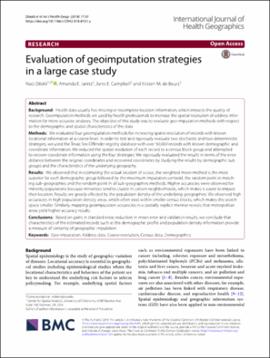| dc.contributor.author | Dilekli, Naci | |
| dc.contributor.author | Janitz, Amanda E. | |
| dc.contributor.author | Campbell, Janis E. | |
| dc.contributor.author | de Beurs, Kirsten M. | |
| dc.date.accessioned | 2018-09-17T19:10:32Z | |
| dc.date.available | 2018-09-17T19:10:32Z | |
| dc.date.issued | 2018 | |
| dc.identifier.citation | Dilekli et al. Int J Health Geogr (2018) 17:30 | en_US |
| dc.identifier.uri | https://hdl.handle.net/11244/301731 | |
| dc.description.abstract | Background: Health data usually has missing or incomplete location information, which impacts the quality of
research. Geoimputation methods are used by health professionals to increase the spatial resolution of address information
for more accurate analyses. The objective of this study was to evaluate geo-imputation methods with respect
to the demographic and spatial characteristics of the data.
Methods: We evaluated four geoimputation methods for increasing spatial resolution of records with known
locational information at a coarse level. In order to test and rigorously evaluate two stochastic and two deterministic
strategies, we used the Texas Sex Ofender registry database with over 50,000 records with known demographic and
coordinate information. We reduced the spatial resolution of each record to a census block group and attempted
to recover coordinate information using the four strategies. We rigorously evaluated the results in terms of the error
distance between the original coordinates and recovered coordinates by studying the results by demographic sub
groups and the characteristics of the underlying geography.
Results: We observed that in estimating the actual location of a case, the weighted mean method is the most
superior for each demographic group followed by the maximum imputation centroid, the random point in matching
sub-geographies and the random point in all sub-geographies methods. Higher accuracies were observed for
minority populations because minorities tend to cluster in certain neighborhoods, which makes it easier to impute
their location. Results are greatly afected by the population density of the underlying geographies. We observed high
accuracies in high population density areas, which often exist within smaller census blocks, which makes the search
space smaller. Similarly, mapping geoimputation accuracies in a spatially explicit manner reveals that metropolitan
areas yield higher accuracy results.
Conclusions: Based on gains in standard error, reduction in mean error and validation results, we conclude that
characteristics of the estimated records such as the demographic profle and population density information provide
a measure of certainty of geographic imputation.
Keywords: Geo-imputation, Address data, Coarse resolution, Census data, Demographics | en_US |
| dc.description.sponsorship | This work was supported by The Oklahoma Center for the Advancement of Science and Technology, Grant No. HR16-048. Article processing charges funded in part by University of Oklahoma Libraries. | en_US |
| dc.language | en_US | en_US |
| dc.rights | Attribution 4.0 International | * |
| dc.rights.uri | https://creativecommons.org/licenses/by/4.0/ | * |
| dc.subject | Geo-imputation | en_US |
| dc.subject | Address data | en_US |
| dc.subject | Coarse resolution | en_US |
| dc.subject | Census data | en_US |
| dc.subject | Demographics | en_US |
| dc.title | Evaluation of geoimputation strategies in a large case study | en_US |
| dc.type | Article | en_US |
| dc.description.peerreview | Yes | en_US |
| dc.description.peerreviewnotes | "International Journal of Health Geographics operates a single-blind peer-review system, where the reviewers are aware of the names and affiliations of the authors, but the reviewer reports provided to authors are anonymous." | en_US |
| ou.group | College of Atmospheric & Geographic Sciences::Department of Geography and Environmental Sustainability | en_US |

